
Original artwork. CLICK for high-resolution image.
Porpoise 1,000-ton littoral submarine concept
 Small submarines pose an elusive threat to naval forces operating in relatively shallow waters, particularly amidst islands. Knowing this the Swedish Navy has a long tradition of building relatively small submarines optimized for the confined waters of the Baltic and particularly among the thousands of islands in the Swedish Archipelago. They were the first navy to introduce the modern form of Air Independent Power (AIP) by converting a Nacken Class submarine in 1989, followed by the Gotland Class in 1995 which had AIP by design. Its closed-circuit Stirling engines generate enough power to propel the submarine at slow speeds. This allows the submarine to operate without snorkeling (putting a mast above the surface to suck in air for the engine) to run the main diesel generators which recharge the batteries. Thus AIP-equipped submarines add persistent to their threat profile, multiplying the dangers to a conventional navy operating in their arena. It was enough of a game-changer that the US Navy leased HSwMS Gotland for two years to exercise against the emerging threat. She conducted exercises from San Diego from July 2005 to July 2007, famously evading defenses and ‘sinking’ the US aircraft carrier USS Ronald Reagan.
Small submarines pose an elusive threat to naval forces operating in relatively shallow waters, particularly amidst islands. Knowing this the Swedish Navy has a long tradition of building relatively small submarines optimized for the confined waters of the Baltic and particularly among the thousands of islands in the Swedish Archipelago. They were the first navy to introduce the modern form of Air Independent Power (AIP) by converting a Nacken Class submarine in 1989, followed by the Gotland Class in 1995 which had AIP by design. Its closed-circuit Stirling engines generate enough power to propel the submarine at slow speeds. This allows the submarine to operate without snorkeling (putting a mast above the surface to suck in air for the engine) to run the main diesel generators which recharge the batteries. Thus AIP-equipped submarines add persistent to their threat profile, multiplying the dangers to a conventional navy operating in their arena. It was enough of a game-changer that the US Navy leased HSwMS Gotland for two years to exercise against the emerging threat. She conducted exercises from San Diego from July 2005 to July 2007, famously evading defenses and ‘sinking’ the US aircraft carrier USS Ronald Reagan.
One of the officers supporting HSwMS Gotland’s visit to San Diego was Fredrik Granholm. Having served in three classes of Swedish submarine over a 16-year Naval career Granholm knows what makes AIP submarines so effective in confined waters. The Porpoise concept is his personal view on the optimal inshore submarine, particularly suited to Swedish operations (and by implication, other confined waters such as Persian Gulf). This is his own design and is not affiliated with any shipbuilder or government agency. Although Granholm is not a naval architect, his engineer’s mind and intimate knowledge of submarines (he is also a submarine historian and author of FRÅN HAJEN TILL SÖDERMANLAND Svenska ubåtar under 100 år) has led to a very detailed and informed design, brought to life in his beautifully illustrated in his plans.
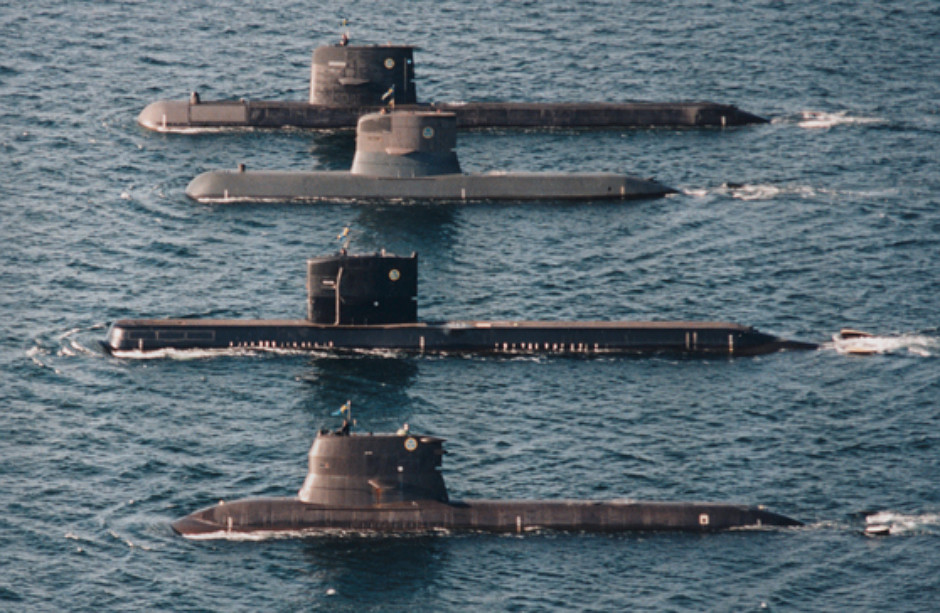
Four generations of Swedish submarine design: A-11 Sjöormen Class from 1960s in foreground, A-14 Näcken Class and A-17 Västergötland Class from 1980s and A-19 Gotland Class from 1990s furthest from the camera. Granholm has served on the A-11. A-17 and A-19 Classes.
Get The essential guide to World Submarines
This Covert Shores Recognition Guide Covers over 80 classes of submarines including all types currently in service with World Navies.Check it out on Amazon
Granholm was motivated to share his Porpoise design after seeing the Covert Shores thought exercise on an ideal US Navy Shallow Water Submersible (SWS). The two designs are essentially takes on a closely related theme, and yet explore different options and aspects. Granholm cautions that he has not done the math that would be required to actually build the Porpoise, but I feel strongly that such a detailed and well thought out design deserves a detailed analysis.
Porpoise 1,000 ton submarine Concept
The Porpoise is a relatively small submarine with a distinctive form. It lacks a sail, and has a chine running the length of the hull. Fredrik Granholm is a skilled draftsman so he has assembled these incredible plans of the Porpoise:
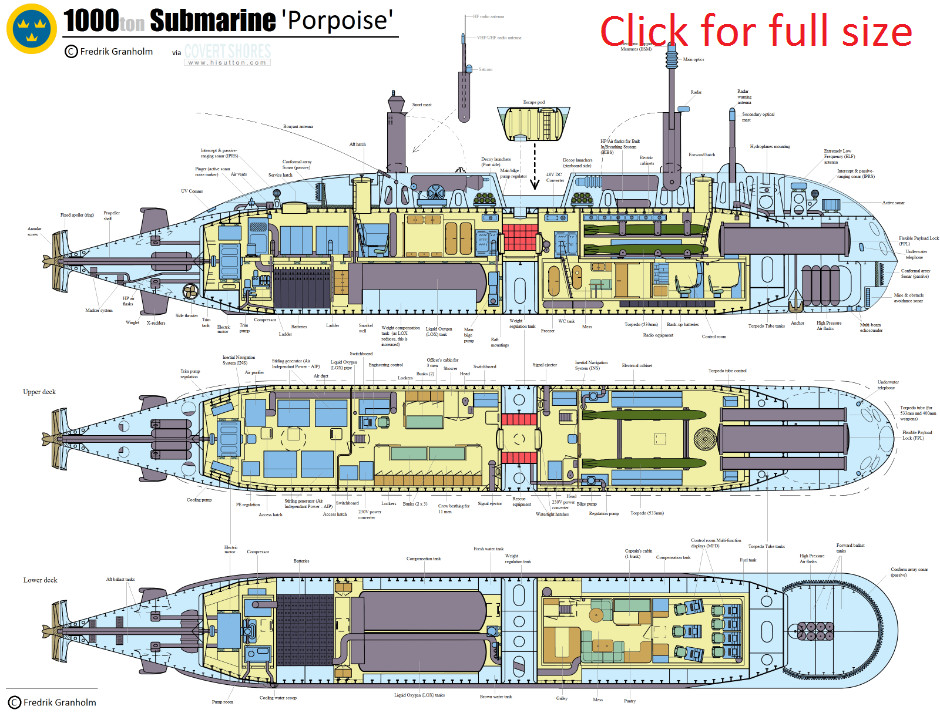
CLICK for high-resolution image.
Small is beautiful
In Granholm’s experience there are few reasons for striving for a large submarine design. Quite the opposite, there are many good reasons for striving towards small submarines.
In submarine design there are numerous reasons why a submarines size grows:
- Demand for long range leads to larger energy storage.
- Demand for long endurance leads to larger supplies and possibly need of more spacious accommodation.
- A larger crew needs more accommodation space, more supplies and increases the hotel-load (energy consumption other than propulsion)
- Demand for higher speed requires larger propulsion that consumes more energy
- Larger payloads require more space.
- Demands for flexibility and adaptability in the design requires more space and power.
And it needs to be emphasized that when size increases because of any above, an even larger propulsion unit is needed to attain required speed, and that in turn will consume even more power. This becomes an ”evil spiral” of ever increasing size…
This counts against the whole idea of the submarine, which is being covert. A smaller submarines is more covert than larger ones. The smaller submarine has less target echo-strength and emits less noise (if the same silencing techniques are used in it – this point may be open to debate).
A smaller submarine can also go places a larger submarine can’t access (especially important in the Baltic and around Sweden’s archipelago). Enemy ASW can exclude shallow waters from their equation if your subs can’t operate in them, and on the contrary, must include them in their equation if you can. Small submarines therefore draw on the enemy’s ASW strength.
THE book on Special Forces subs Covert Shores 2nd Edition. A world history of naval Special Forces, their missions and their specialist vehicles. SEALs, SBS, COMSUBIN, Sh-13, Spetsnaz, Kampfschwimmers, Commando Hubert, 4RR and many more.
Check it out on Amazon
And it is not all about shallow depths, it is also about maneuverability and position holding in confined waters.
A smaller submarine also needs fewer crew and consumes less supplies which leads to reduced running costs. And building smaller submarines consumes less material which makes them less costly to build. The porpoise design has an estimated unit cost of between 200-250 million USD if production runs are sufficient.
This all translates into a larger quantity of submarines, which Sweden (or many other potential operators) could never afford if building larger submarines. Building larger submarines, however more capable, can never (!) fully compensate for insufficient numbers (Sweden plans just 2 A26 boats!). Only a sufficient quantity allows you to disperse your units to many areas simultaneously. And only a sufficient quantity allows you to sustain losses without losing all of your fighting capability.
Summing it up, there are many good reasons for striving towards more small submarines rather than a few larger ones.
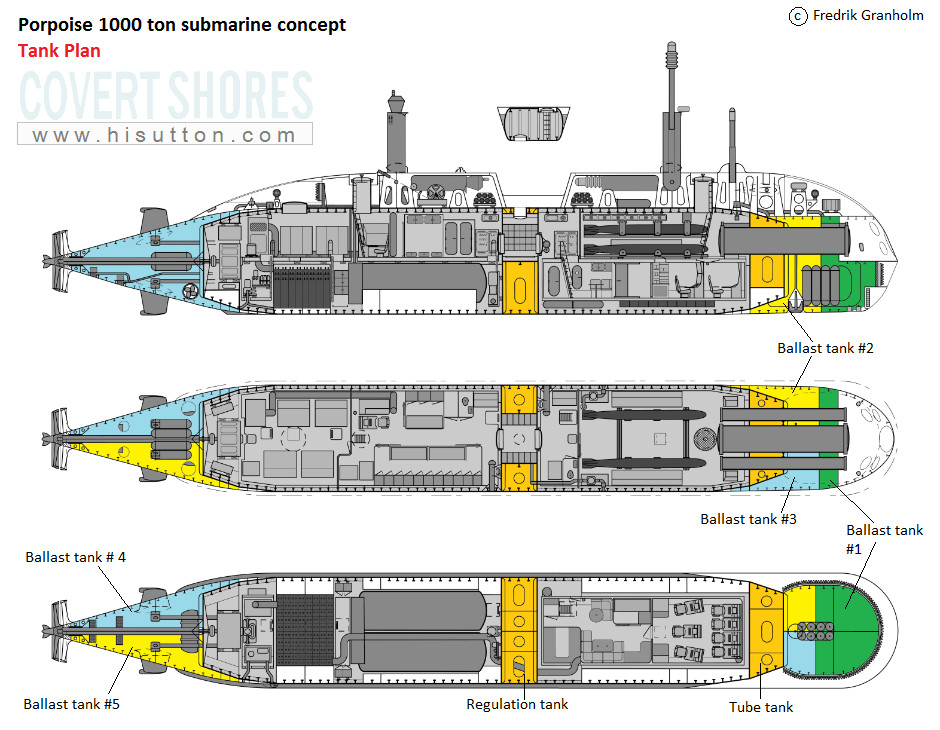
Main tanks affecting submergence. Omits internal compensation tanks, fuel, freshwater etc.
The small size does require compromises however. To reduce the size of a submarine optimized for operations in the Baltic, it is easy to cut down on the range requirement. A range that allows for a submerged round-trip of the Baltic should be enough, together with an endurance that allows for at least two weeks full submergence. Endurance is primarily limited by the hotel-load and the crew should therefore be kept as small as possible.
Original artwork. CLICK for high-resolution image.
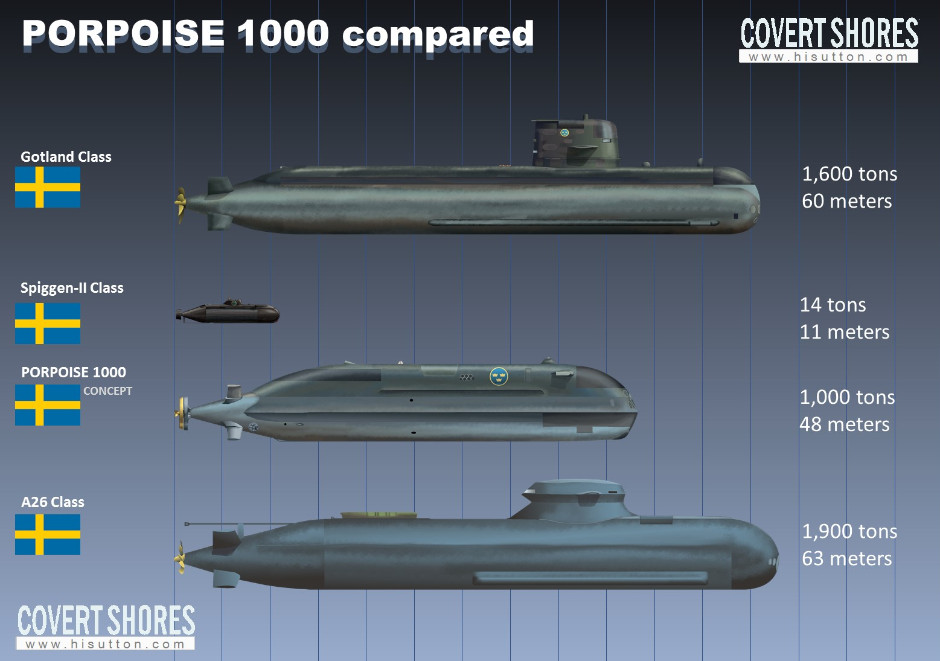
Design influences
The design is in some respects similar to the unbuilt Swedish UBåt-2000 ‘Flundran’ (Submarine 2000 ‘Flounder’, aka Ub-2000) design which was intended to follow the Gotland. That featured AIP-only propulsion and no virtually sail. It was replaced on the drawing board by the less adventurous Viking Project (also unbuilt) which led to the latest A26 Class.
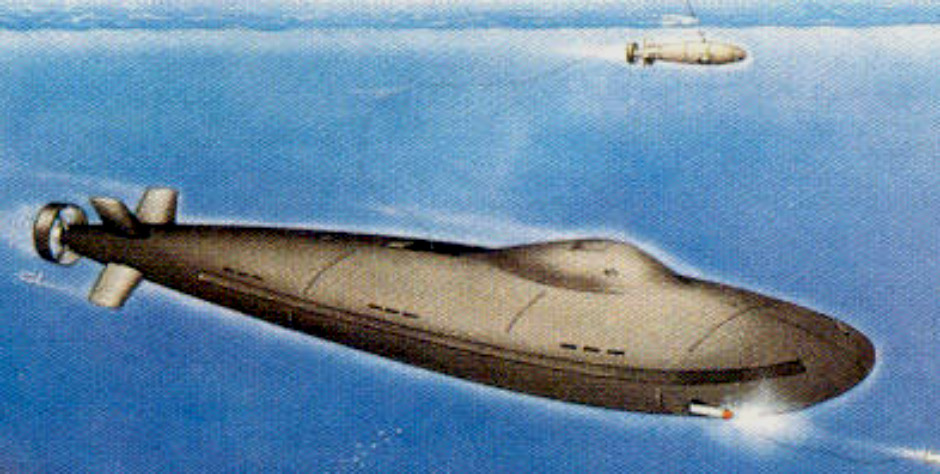
There were a number of designs developed under Ub-2000 but the ‘flounder’ gets all the attention here. It had a double-hull but with minimal spacing on the top and bottom but wide on the sides, like a flatfish. This reduced its target strength and provided ample space for equipment externally to the hull. The conventional periscope was to be replaced by an electro-optical mast and a tethered ROV with masts which could rise from the submarine to near the surface like a buoy. These features allowed the sail to be absolutely minimized to just a hump to cover the main access hatch.
Granholm was also influenced by the unbuilt World War Two German Type-XXIX H U-Boat. This little-known design was incredibly advanced for its time and featured a chine along either side to deflect active sonar similar to faceted stealth which only emerged in the 1980s elsewhere:

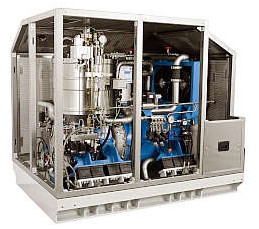 All-AIP submarine
All-AIP submarine
One of the features borrowed from the Ub-2000 is the all-AIP propulsion. There is no diesel generator to recharge the batteries, instead four closed-cycle Stirling engines are used to power the electric motor which drives the propeller, plus supply all hotel loads (lighting, sensors, refrigeration, galley…). The batteries are used as an extra boost to get the submarine out of trouble (14 knots is still only a modest maximum speed!) and power the boat when the Stirlings are switched off.
Because of this the batteries have to be charged before the boat leaves port, and cannot be fully recharged until it returns. This greatly limits its endurance relative to larger submarines but does not overly limit the types of mission the boat is designed for. The Stirlings can be used to top up the batteries, or to recharge them but it is inefficient.
Operational effectiveness
The Porpoise is equipped with two modern conformal sonar arrays (COAS), one in the bow and a second above the stern. Combined with side-scan sonar, a forward looking mine and obstacle avoidance sonar (MOAS), and the regular sensor masts and communications (for example a floating antenna) this would provide excellent all-round situational awareness for such a small boat. There is no towed sonar array because they are difficult to deploy and operate in brown waters (littorals), and offer virtually no extra detection range in confined waters.
Swedish submarines have long-since led the field in automation with minimal crewing requirements. For example since the 1960s Swedish boats have been ‘driven’ by a single helmsman operating the steering and X-rudders, whereas other submarines required three crewmen (1. Rudder 2. Forward hydroplanes 3. Aft hydroplanes) plus an NCO supervising. This dates back to the 1950s when the Swedish Chief of the Navy, Vice Admiral Stig H:son Ericson (1953-61) was a personal friend of his US counterpart Admiral Arleigh Burke. This gave Sweden unique insight into US Navy advances during those years, especially so the revolutionary USS Albacore with her one-man steering and x-rudders.
The one-man steering console was introduced on the A12 Draken Class and taken further on the A11 Sjöormen Class where the helmsman was also given the responsibility for trim- and weight-regulation, reducing crew even further. The helmsman of the Sjöormen controlled the aileron (banking) functionality with two pedals. This complicated steering for only a slight benefit in maneuverability and so was not incorporated into later designs.
Crew reduction started with the Sjöormen Class. Although it was much larger than the proceeding Draken Class (1,100 tons versus 700 tons), the crew was reduced from 44 to just 21 men. On the following A14 Näcken Class automation was taken to the limit (?) with a crew of just 19. From then on crew sizes had to increase slightly to man the much more advanced sensors.
The Porpoise has a crew of just fifteen (two watch system with 6 persons in each watch and 3 ”watch free” (CO, Chief engineer and the chef)). This is possible due to further increases in technology. Consequently operational costs are reduced and it would be possible to crew more submarines from the same pool of trained submariners.
The removal of conventional periscopes (replaced by multi-sensor electro-optical masts) allows the control room to be relocated from under the sail (which is conspicuously absent!) to the forward hull.
Survivability
The Porpoise design incorporates extensive raft mountings of almost all internal spaces plus double-raft mountings for machinery and potentially noisy equipment. And is equipped with two 7-round decoy launchers built into the casing.
One feature which betrays that this design comes from a submariner is the rescue capsule. This is relatively rare in Western submarines (except the German designed Type-209 1400 operated by India) but is common in Russian designs. It is a sealed pressure chamber which the crew can retreat to in case of an emergency. It is then released from the submarine and floats to the surface where the crew can be rescued.
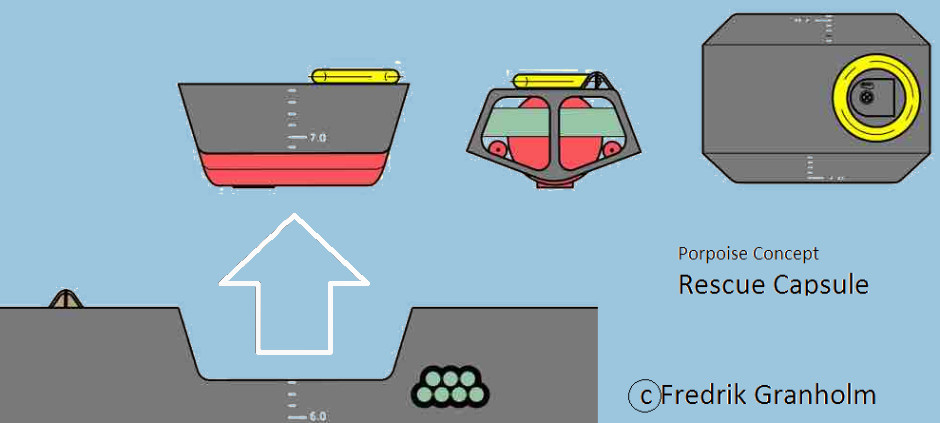
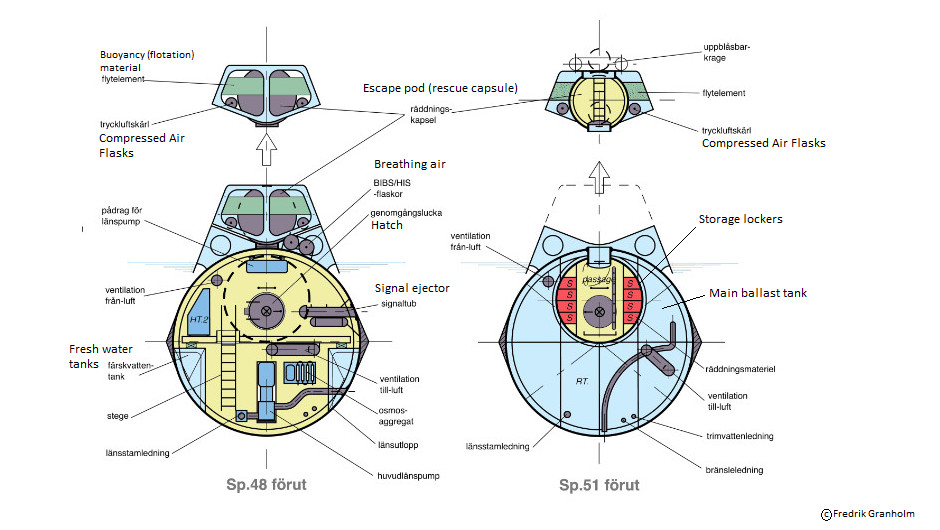
Granholm’s detailed plans of the escape pod. Note also the signal ejector in the left cross-section. There are two of these, one either side, which allow a damaged submarine to signal its location to rescuers.
Escape pods take a considerable space and weight in the submarine and are widely criticized as unnecessary as they are only useful in limited circumstances because of its limited depth capability (which matches the submarine). For example if the submarine sinks in the mid-Atlantic the escape pod would be crushed before the crew could all get inside and jettison it. But the Porpoise is primarily designed for operations in the Baltic and other shallow waters (littoral/brown-waters), so the pod would almost always be useful.
Special Forces capability
Porpoise has Special Forces capabilities designed-in with a large Flexible Payload Lock in the bow between the torpedo tubes. This feature was influenced by the A26 design and can lock-out or lock-in all 12 Special Forces passengers simultaneously. Because the torpedo room is placed on the upper deck the divers are as close to the surface as practical which increases the chances that they can use their own pure-oxygen rebreathers during the locking out/in evolution if operationally desirable (pure oxygen rebreathers are only safe down to depths of around 7 meters (23 feet)). The FPL can also accommodate small swimmer delivery vehicles like the Swedish designed Torpedo-SEAL and Unmanned Underwater Vehicles like the Saab Double Eagle. Smaller UUVs such as the Saab SUBROV can also be deployed this way, or via the torpedo tubes.

Granholm’s plans of the torpedo room with central FPL

The Torpedo-SEAL, SUBROV and Double-Eagle UUV
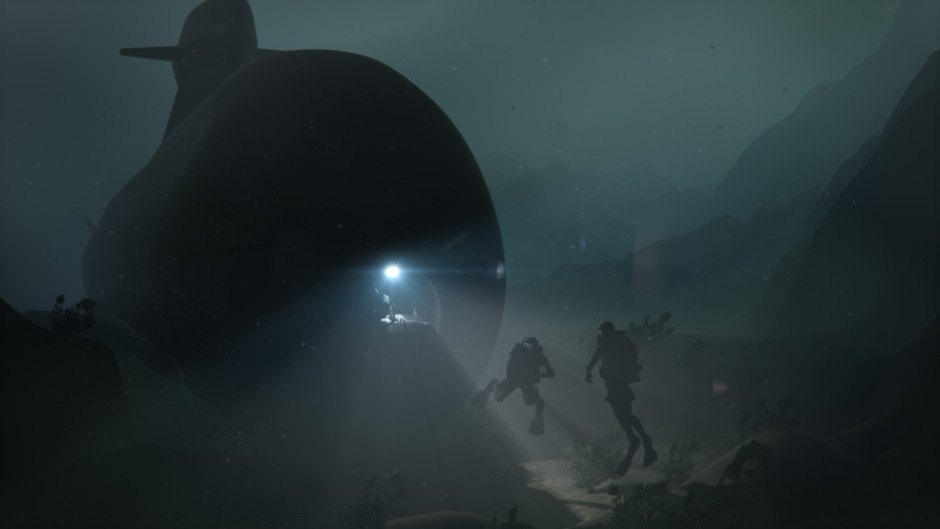
Illustration of the FPL on the A26 Class. Source: Saab

Detail of the FPL on the A26 Class. Source: Kockums
In the Porpoise the torpedo room is located n the upper deck with the control room beneath it. This unusual arrangement has the clear advantage in allowing the FPL to be closer to the surface which reduces the needs for diver decompression as they are nearer the surface. And in some circumstances Special Forces divers can use their pure-oxygen rebreather diving apparatus which has a safe operating depth of just 7 meters (23 ft).
Specifications
Surface displacement: approx. 1000 ton
Reserve displacement: approx. 10%
Length: 48.5 m (160 ft)
Beam: 6.3 m (21 ft)
Height: 8 m (26ft)
Draught: approx. 5.4 m (18 ft)
Pressure hull diameter: 6.0 m (20 ft)
Rib spacing: 0.5 m (1.6 ft)
Operational diving depth: 150 m (492 ft) – crush depth 300 m (950 ft)
Endurance: 2-3 weeks
Max speed: approx. 9 knots surfaced, 14 knots submerged on batteries, 10 knots submerged on AIP alone
Torpedo tubes: 4 (length 7 m inner diameter 0.7 m) suitable for 8 x 533mm (21”) torpedoes or 16 400mm (15.75”) torpedoes.
FPL (Flexible Payload Lock): 1 (length 7 m inner diameter 1.7 m). Normally used for Special Forces, the FPL can hold liners for 4 heavyweight torpedoes for a maximum loadout of 12 heavyweight torpedoes.
Crew: 15 (two watch system with 6 persons in each watch and 3 ”watch free” (CO, Chief engineer and the chef)
Passengers: 12 Special Forces accommodated in torpedo room
Armament
The Porpoise is equipped with four 533mm (21”) torpedo tubes for heavyweight torpedoes such as the Swedish Type-613 and more modern Torpedo-62 or other types per customer requirements. Ordinarily four reloads can be carried in the torpedo room for a full load of eight full-sized weapons. Additionally the FPL can be loaded with liners for four additional torpedo tubes giving a maximum load of twelve full sized torpedoes. To save weight the torpedo tubes are swim-out only, which also fits with the operating conditions (speeds and depths) of the submarine.
The Type-613 is a wire-guided and passive homing weapon equipped with a 240kg (530 lb) warhead. It has a range of 11 nm at 40 knots.
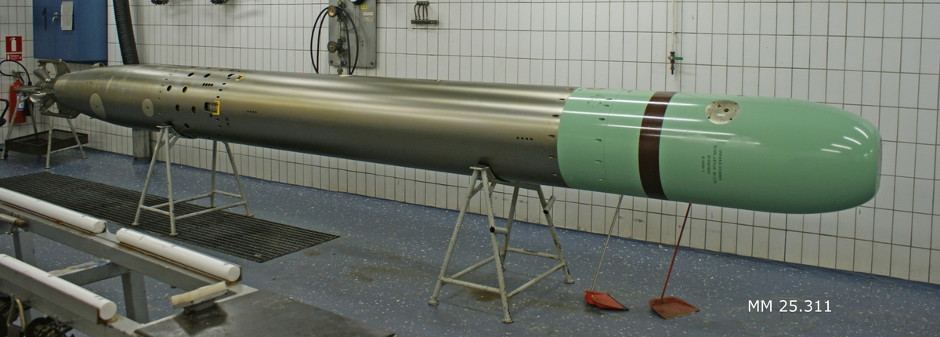
Type-613, photo from the Maritime Museum at Karlskrona
The more recent Torpedo-62 is also wire guided and can track and classify several targets simultaneously. It has four times the range of the Type-613 at 40 nm at the same speed of 40 knots.
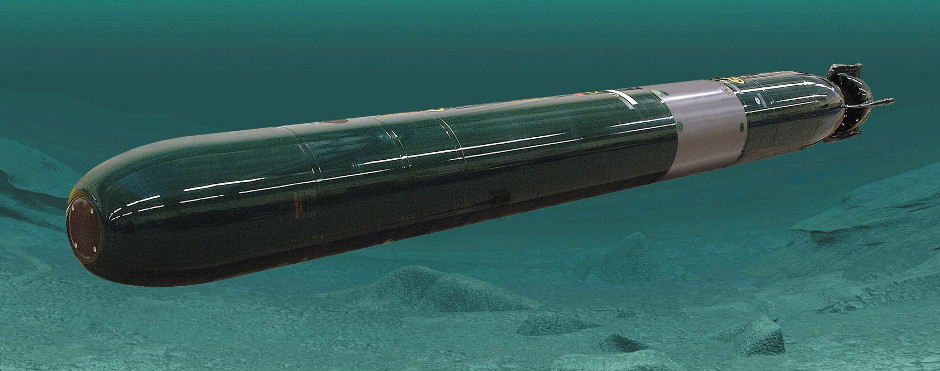
Torpedo-62, Saab
Both Swedish weapons are powered by the controversial Hydrogen-Peroxide fuel. This is potentially dangerous – ref Kursk and HMS Sidon disasters. The Swedes however have a long and safe experience of hydrogen-peroxide. They have conducted a massive number of test firings from all their submarines since the 1960s and continue in double digits per submarine per year. So there must have been many thousands of peroxide torpedo launches in the Swedish navy. The fuel does require high quality materials and a high standard of training and safety awareness of course.
In common with larger Swedish submarines the torpedo tubes can also be used to fire smaller 400mm (15.75”) torpedoes. Sweden is unique in fielding wire-guided torpedoes (with passive or active terminal homing) in the lightweight class. Wire guidance has been found to be more reliable than fire-and-forget weapons in the confined and crowded Baltic, especially in the archipelagoes.
The electric powered Saab Torpedo-45 is the latest generation of Swedish 400mm weapon. It is just 2.85 meters (9.3 ft) long and weights 320 kg (705 lb). Range is somewhat shorter than the Torpedo-62 but they have the advantage that two can be accommodated in each torpedo tube. They can then be tandem fired against the same or different targets. Swedish submarines hold the record for multiple simultaneous wire-guided torpedo launches from the same submarine and the Porpoise firing a full load of 16 Torpedo-45s (8 from the 4 torpedo tubes plus 8 from the four liners in the FPL) simultaneously is not technically farfetched.

Torpedo-45, photo by Visa Villkor
Although the swim-out torpedo tubes are not capable of launching large anti-ship missiles such as Sub-Harpoon which require an impulsor (some way of ejecting an object from the torpedo tube – adds weight and complexity), they could be used to launch some smaller missiles. The prime example is the new German IDAS (Interactive Defence and Attack System) which is launched from a four-round magazine inserted into a torpedo tube. The IDAS is a new class of weapon which provides self-defense and asymmetric warfare capabilities while the submarine is submerged. It can target anti-submarine warfare (ASW) helicopters, low performance aircraft (e.g. Maritime Patrol Aircraft (MPAs)) and also small/medium-sized surface vessels. It also has a limited precision strike capability against pre-selected coastal targets, which is of particular relevance for Special Forces.
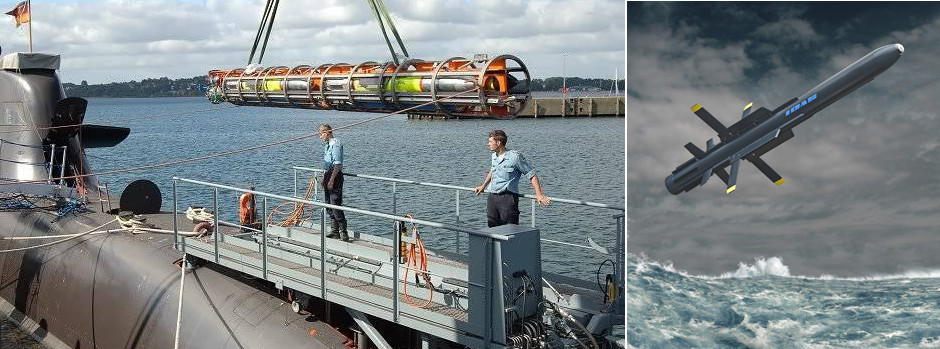
A quad-pack of IDAS missiles is loaded aboard a German Navy Type-212 submarine
Forward deployment
The Porpoise is intended for operations in confined seas such as the Baltic and Persian Gulf. One of the accepted limitations of small diesel-electric / AIP submarines is their relatively short endurance and slow speed. Unlike nuclear attack submarines they are not in their element traversing great distances to deploy from home bases to their operating areas. The Porpoise would therefore need to be based near to its operating area, which if that is far from Sweden would mean forward deploying. The fact that HSwMS Gotland was carried to the US by a semi-submersible transport dock is not lost on Granholm. This was cheaper than sailing there and allowed the crew to take leave and during the voyage. Once in San Diego the submarine was ready for operations in only a few days, and that was without any wartime urgency. The Porpoise design is small enough that four could be carried by a single transport dock meaning that one ship could economically deploy a functioning submarine squadron from Sweden to any operating theatre in the world.
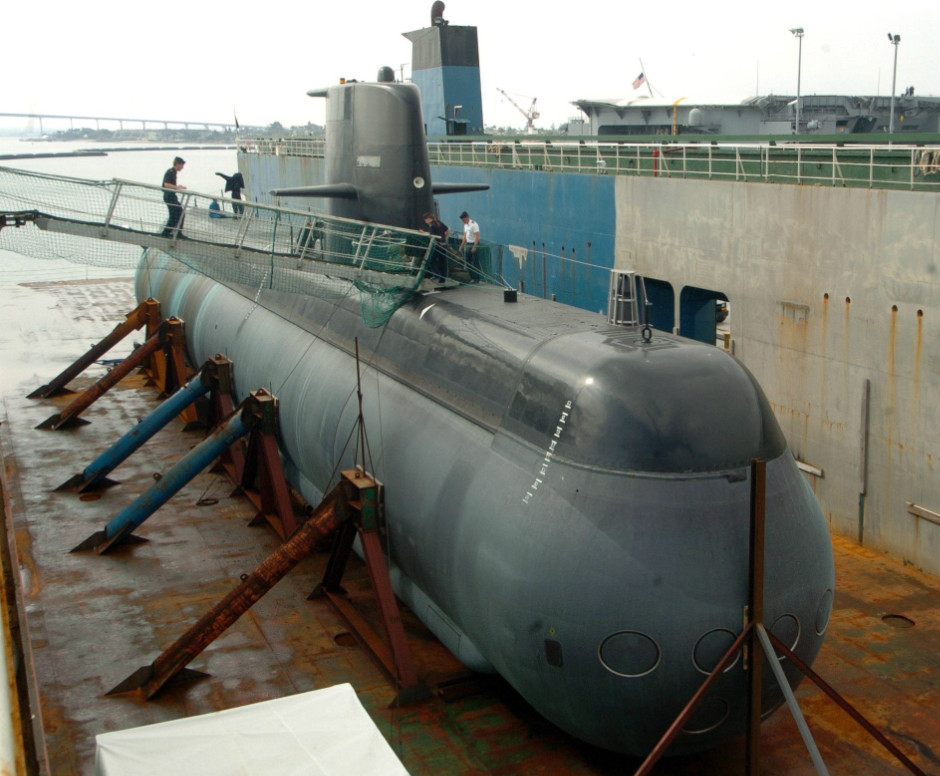
HSwMS Gotland was carried to San Diego on the Norwegian semi-submersible transport MV Eide.
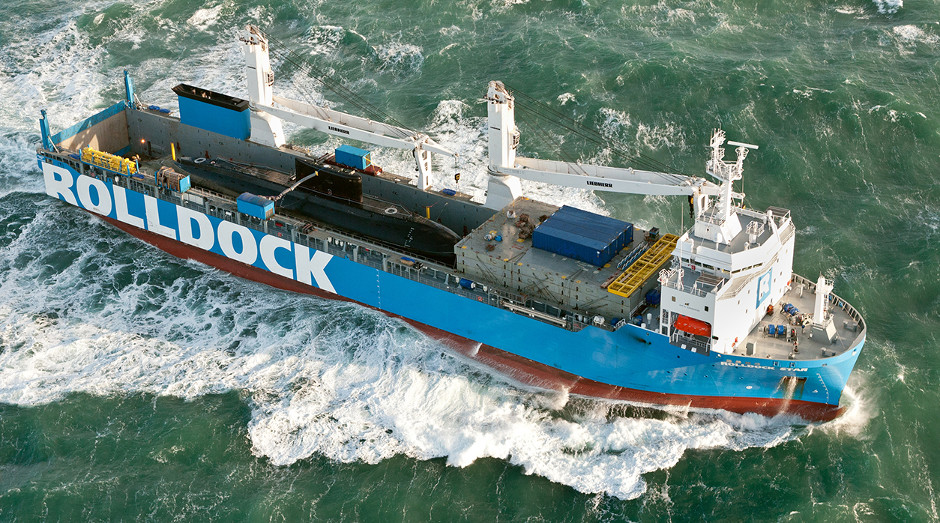
Dutch semi-submersible transport dock Star seen carrying a Russian built KILO Class submarine to Vietnam
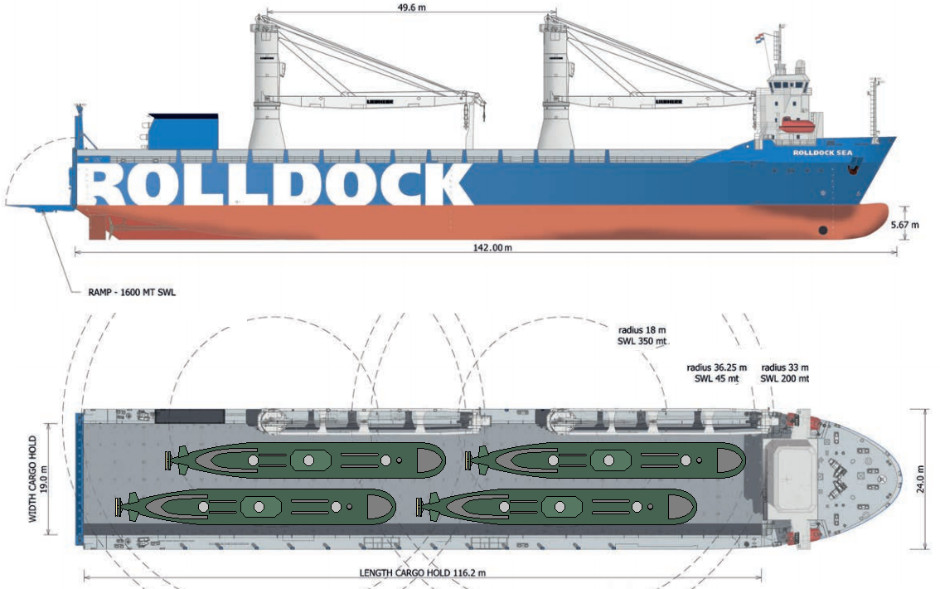
The Rolldock S-Class shown with four Porpoise-1000 submarines. It’s capacity it 4,000 tons.
Related articles (Full index of popular Covert Shores articles)

 A-26 Class attack submarine. w/Cutaway
A-26 Class attack submarine. w/Cutaway















 World survey of AIP submarines
World survey of AIP submarines


 TorpedoSEAL Diver Propulsion Device
TorpedoSEAL Diver Propulsion Device

 WTD-71 Aquatechnik SDV projects
WTD-71 Aquatechnik SDV projects

 Narwal / Orca Dry Combat Submersible (UWTG)
Narwal / Orca Dry Combat Submersible (UWTG)

 Naval Spetsnaz in Hybrid Warfare (Russian SDVs and DPVs)
Naval Spetsnaz in Hybrid Warfare (Russian SDVs and DPVs)

 Comex Sagittaire midget submarine
Comex Sagittaire midget submarine

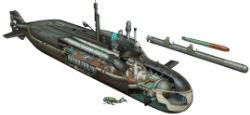 Piranha Class (LOSOS) midget sub
Piranha Class (LOSOS) midget sub

 Iranian Fateh Class SSK
Iranian Fateh Class SSK

 HDS-500 Midget Submarine
HDS-500 Midget Submarine

 Maritalia GST-23+ Midget Submarine
Maritalia GST-23+ Midget Submarine


 Analysis of Swedish submarine incursion- Luleå 1983
Analysis of Swedish submarine incursion- Luleå 1983

 Yantar spy ship loitering over undersea cables
Yantar spy ship loitering over undersea cables
 Russia seeks submarine advantage in Arctic (SHELF system, GUGI special mission subs)
Russia seeks submarine advantage in Arctic (SHELF system, GUGI special mission subs)

 Barbel Class - the last front-line diesel boats int the US Navy
Barbel Class - the last front-line diesel boats int the US Navy




